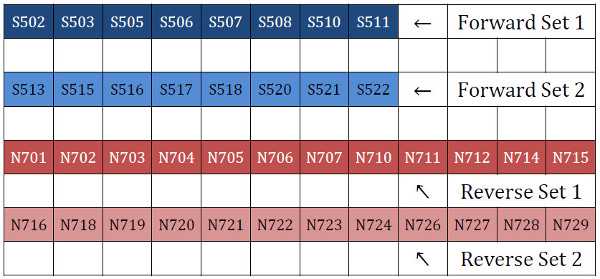Preparing Indexed Primer Plates (IDT Ultramers) for the Illumina MiSeq - Nextera Dual Indices
André M Comeau, Alessi Kwawukume
Abstract
The preparation of diluted IDT working primer stocks of Illumina Dual Index primers for use in IMR PCR preps.
Steps
Order Primers
Use our Excel template (Illumina-CDI-8bp-customfusionprimers-template.xlsx) to copy existing 16S/18S/ITS primers or to design your own custom gene primers with the proper Illumina indices and Nextera adapter orientations. We order IDT “Ultramers” for such long primers (~80-90 nt) as their coupling efficiency is one of the highest available (critical for obtaining high proportions of full-length oligos in the mix you obtain). Order the fusion primers at 4nanomolar (nM) scale in deep-well plates (DWP); one set per 96-well plate, arranged as follows, leaving blank rows in between sets:

Prepare Archival Stocks
Once arrived, do a short spin of the plate in case lyophilized material was dislodged, then add 400µL of PCR-grade water to each well containing the primers in order to reconstitute them at a concentration of 10micromolar (µM) (1/10th the typical 100 µM working stock concentration for primers). Mix well by pipetting up and down at least 3 times and seal the plate with Bio-Rad film. Alternatively, the plate is sealed with Bio-Rad film and mixed well by vortexing it on a benchtop vortex for 0h 0m 30s and then doing a short spin at approx. 500rpm. We have found that these primers usually need a significant incubation time for the lyophilized pellets to re-suspend well – we typically leave them overnight at 4°C before continuing.
Prepare Working Stocks
Prepare the 1micromolar (µM) working stock Forward Set 1 Primer Plate (F1) by pipetting 90µL of PCR-grade water into each well of the 96-well PCR plate from a sterile reservoir. Rotate the deep-well primer plate 90° clockwise and align it so that the 8 occupied wells (= 8 different indices) of row 1 line up with the 8 rows of the new plate. Working by column and keeping the same set of tips, transfer 10µL of reconstituted primer into each well of each column, mixing well by pipetting. Once complete, each column of the resulting plate will have enough primer for two complete 96-well plate PCRs (the Pure+1/10th plates; 12 columns × 4 µL × 2 plates = 96 µL required). Seal the plate with PCR film and store at -20°C.
Prepare the 1micromolar (µM) working stock Forward Set 2 Primer Plate (F2) by repeating Step 3, but using row 3 of the reconstituted deep-well primer plate.
Prepare the 1micromolar (µM) working stock Reverse Set 1 Primer Plate (R1) by pipetting 63µL of PCR-grade water into each well of the 96-well PCR plate from a sterile reservoir. Align the deep-well primer plate horizontally (normal orientation) so that the 12 occupied wells (= 12 different indices) of row 5 line up with the 12 columns of the new plate. Working by row and keeping the same set of tips, transfer 7µL of reconstituted primer into each well of each row, mixing well by pipetting. Once complete, each row of the resulting plate will have enough primer for two complete 96-well plate PCRs (the Pure+1/10th plates; 8 rows × 4 µL × 2 plates = 64 µL required). Seal the plate with PCR film and store at -20°C.
Prepare the 1micromolar (µM) working stock Reverse Set 2 Primer Plate (R2) by repeating Step 5, but using row 7 of the reconstituted deep-well primer plate.
Once all aliquoting is complete, seal the deep-well plate with PCR film and archive at -20°C until new aliquots are required (minimized freeze-thaw cycles).
(Optional) Prepare Blocking Primer Stocks
Optional: For the generation of 18S V4 amplicons from microbiome samples containing substantial non-target host DNA (ex: human, mouse, etc.), order (ex: from PNA Bio) a custom PNA mammalian blocking primer (elongation arrest in the V4 region) with the sequence: 5’- TCTTAATCATGGCCTCAGTT -3’ (courtesy of Laura Parfrey and Matt Lemay, UBC). Once arrived, prepare an archival stock of 100micromolar (µM) and a working stock of 10micromolar (µM) using PCR-grade water.

